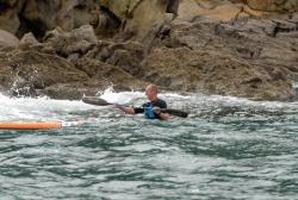Safety

NOTE: This page is currently being updated... check back soon!
No matter what type of kayak you are using there are some basic safety considerations that every kayaker should be aware of and follow:
PFD - Always wear an appropriately rated and sized personal floatation device (PFD). It is now law in New Zealand and Australia that a PFD is worn while on any watercraft.
Clothing - Regardless of what type of kayak you use, venture out prepared to get wet, it is vital to dress for the water temperature.
Do not wear any item of clothing that will ‘weigh you down’ when in the water eg. jeans, boots etc.
Visibility - If you are intending to go any distance offshore, for example a kayak fishing or diving expedition, or kayak touring then it is important that you improve your visibility to other watercraft by:-
Self Rescue - We suggest you practice self-rescue techniques in shallow water first. As part of any practice it is important to learn how to right a capsized kayak/ski.
Weather Conditions - Check weather conditions and forecasts before paddling. Remember weather conditions can change quickly.
Avoid strong offshore winds.
Know Your Limitations - Paddling long distances can be tiring, particularly if you are new to kayaking. Don’t attempt kayaking trips that may overextend you physically, always factor in that the paddle back maybe harder than the paddle out (i.e. due to headwinds or current).
Sea Condition - Be sure you fully understand local tides and currents before going out in your kayak.
Avoid Losing Your kayak/ski - a leg leash which attaches to your surfski is highly recommended.
Kayak Surfing - Kayak surf away from crowded areas, always allow for a clear run into the shore.
Kayak Check - Finally, check your kayak before setting out. In particular ensure all hatches and bung holes are firmly closed and watertight. Hatches should not be opened while on the water.
No matter what type of kayak you are using there are some basic safety considerations that every kayaker should be aware of and follow:
PFD - Always wear an appropriately rated and sized personal floatation device (PFD). It is now law in New Zealand and Australia that a PFD is worn while on any watercraft.
Clothing - Regardless of what type of kayak you use, venture out prepared to get wet, it is vital to dress for the water temperature.
Do not wear any item of clothing that will ‘weigh you down’ when in the water eg. jeans, boots etc.
Visibility - If you are intending to go any distance offshore, for example a kayak fishing or diving expedition, or kayak touring then it is important that you improve your visibility to other watercraft by:-
- Using a colourful kayak
- Wearing a bright colourful PFD and paddle jacket
Self Rescue - We suggest you practice self-rescue techniques in shallow water first. As part of any practice it is important to learn how to right a capsized kayak/ski.
Weather Conditions - Check weather conditions and forecasts before paddling. Remember weather conditions can change quickly.
Avoid strong offshore winds.
Know Your Limitations - Paddling long distances can be tiring, particularly if you are new to kayaking. Don’t attempt kayaking trips that may overextend you physically, always factor in that the paddle back maybe harder than the paddle out (i.e. due to headwinds or current).
Sea Condition - Be sure you fully understand local tides and currents before going out in your kayak.
Avoid Losing Your kayak/ski - a leg leash which attaches to your surfski is highly recommended.
Kayak Surfing - Kayak surf away from crowded areas, always allow for a clear run into the shore.
Kayak Check - Finally, check your kayak before setting out. In particular ensure all hatches and bung holes are firmly closed and watertight. Hatches should not be opened while on the water.
